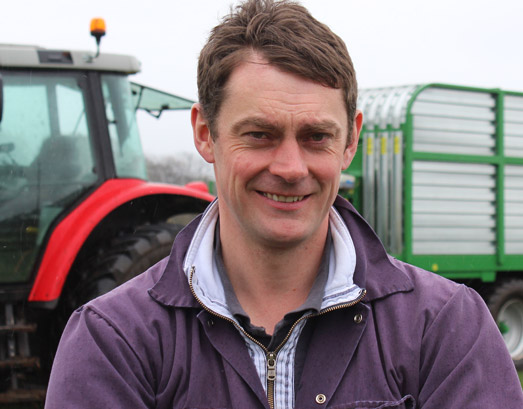Scott McColm
Dairy Farmer
- 250 Ayrshires yielding 7,400 litres, with 4.4% butterfat and 3.4% protein
- Grazing efficiency increased to around 90%
- Target of 3,500 litres from forage
- Concentrate usage reduced saving around 2ppl
- Silage requirement reduced by 15-20%, so reducing contractor cost
- Land released for cropping with spring barley, which will further reduce costs
Zero grazing for improved grass utilisation
In a move described as one of the biggest changes for 30 years, moving from a grazing based system to zero grazing has enabled a south west of Scotland dairy farm to considerably improve grass utilisation and reduce costs.
Brothers John, Brian and Sam McColm, plus John’s son Scott, run a 250 cow pedigree Ayrshire herd on their farm near Stranraer. Like many herds in the country, in the past the cows were turned out during the summer months for grazing. However, faced last year with poor weather and wet ground conditions, the decision was made to change to all-year housing and to invest in a Grass Tech Grazer 120 zero grazer, which arrived in early August, in order to bring the fresh grass to the cows.
“It’s early days and we only used the Grazer from August through to November, but even in that time the benefits were considerable and will only increase this year when we have a full season’s use from it,” says Scott.
“The biggest benefit is that grass utilisation is considerably increased. With a grazing system you achieve about 65% efficiency, but with zero grazing it’s nearer 90%. It has allowed us to extend the grass season by about a month and the cows are far happier. Previously, if it was wet they would just stand there looking unhappy not eating. But now they are far more content and you can see that they are full all the time. As a result we should also see less incidents of displaced abomasum and digestive problems.”
Average yields for the herd, which was established over 70 years ago, run at about 7,400 litres/cow with butterfats of 4.4% and protein at 3.4%. All the milk is sold to the Caledonian Cheese Company for use in their Seriously Strong Cheddar.
“Ultimately it’s all about grassland management and producing more milk from forage. At present forage accounts for about 2,700 to 2,800 litres. If we can get to at least 3,500 of the 7,500 from forage then I will be more than happy. The biggest benefit will come in the shoulder of the year when yields will stay higher because the cows have been fed high quality grass all season.”
By housing the cows and zero grazing, the McColms’ aim is for the high yielders to get 75% of dry matter from grass. First thing in the morning they are be fed a TMR mix allowing 15kg fresh weight including 6kg of whole crop, which when finished is topped up with zero grazed grass, allowing 70-75kg per cow, and they are then fed up to yield in the parlour with high fibre cake. The lower yielding cows are just fed on fresh grass and cake in the parlour.
“One immediate difference has been the reduction in concentrate use, which is saving us at least 2 pence a litre,” states Scott. “On top of that, by improving grass utilisation we need less grazing acres, so that land has gone into barley, which will also help reduce concentrate use but also the need to buy in straw, which at up to £95 a tonne is expensive due to haulage.”
“TMR is fine, but it’s not what cows are designed to eat and by extending the grazing season by zero grazing from late March to at least October, we will probably need about 15 to 20 percent less silage, so there will also be a reduction in contractor cost. “
An additional benefit is that by not grazing, there has been a noticeable improvement in the sward, which is thicker and clover has also started to reappear. The McColms’ have always renewed leys on a regular basis but with zero grazing have found that while a ley may look good in the field, the cows don’t perform as well on grass from older leys.
“We aim to renew every 7 to 8 years,” says Scott, “but now will also look at earlier, higher sugar varieties. The plan is that we will go in with the Grazer about every 3 weeks and harvest about 3.5 tonnes per hectare leaving a 3 inch stubble.”
“The Grass Tech Grazer is definitely a well built machine, easy to use and because it’s fitted with wider tyres it hardly leaves a mark and certainly makes less mess than a cow would,” he concludes.

 Denmark
Denmark Netherlands
Netherlands Kenya
Kenya
